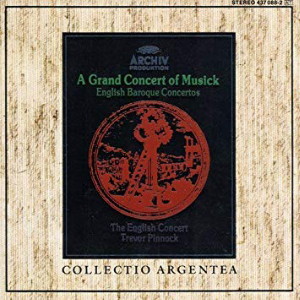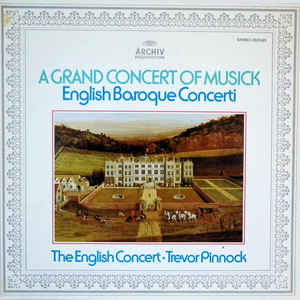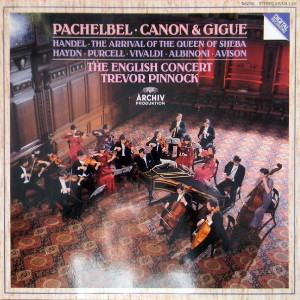 |
|
1 CD -
437 088-2 - (c) 1986
|
 |
| 1 LP -
2533 423 - (p) 1979 |
 |
| 1 LP -
415 518-1 - (p) 1985 |
|
| A GRAND CONCERT
OF MUSICK |
|
|
|
|
|
John
Stanley (1712-1786)
|
|
|
Concerto in G
minor op. 2 no. 3
|
8'
41" |
|
| Scoring:
Concertino: Violin I/II,
Violoncello; Concerto grosso:
Violin I (3), Violin II (3),
Viola (3), Violoncello (1),
Double Bass (1), Harpsichord
|
|
|
| 1. Adagio - Allegro |
4'
05" |
|
| 2. Andante |
1'
44" |
|
| 3. Allegro |
2'
52" |
|
|
|
|
| Thomas
Arne (1710-1778) |
|
|
| Concerto in G
minor for Keyboard and Orchestra |
11'
31" |
|
| Scoring:
Harpsichord solo; Violin I (4),
Violin II (4), Viola (3),
Violoncello (2), Double Bass (1) |
|
|
| 1. Largo - Allegro
con spirito |
4'
33" |
|
| 2. Adagio |
3' 03" |
|
| 3. Vivace |
4' 31" |
|
|
|
|
| William
Boyce (1711-1779) |
|
|
| Symphony in B
flat major |
6'
57" |
|
| Scoring: Flute
I/II, Oboe I/II, Violin I (5),
Violin II (4), Double Bass (1) |
|
|
| 1. Allegro |
2'
38" |
|
| 2. Moderato
e dolce |
2'
22" |
|
| 3. Allegro |
1' 57" |
|
|
|
|
| Francesco Geminiani
(1687-1762) |
|
|
| Concerto grosso
in D minor (after Corelli: "La
Follia" Variations, op. 5 no. 12) |
12'
18" |
|
| Scoring:
Concertino: Violin I/II, Viola,
Violoncello, Harpsichord;
Concerto grosso: Violin I (3),
Violin II (3), Viola (2),
Violoncello (1), Double Bass
(1), Organ, Harpsichord |
|
|
|
|
|
| Pieter Hellendaal
(1721-1799) |
|
|
| Concerto in E
flat major op. 3 no. 4 |
11'
44" |
|
| Scoring:
Concertino: Violin I/II, Viola,
Violoncello, Harpsichord;
Concerto grosso: Violin I (5),
Violin II (4), Viola (3),
Violoncello (2), Double Bass
(1), Organ, Harpsichord |
|
|
| 1. Grave sostenuto |
3'
58" |
|
| 2. Alle breve |
1'
41" |
|
| 3. Affettuoso |
1'
34" |
|
| 4. Presto |
1' 34" |
|
| 5. Pastorale |
2' 58" |
|
|
|
|
| Charles
Avison (1709-1770) |
|
|
| Concerto grosso
no. 9 in C major/A minor
(after Domenico Scarlatti:
"Lessons for the Harpsichord") |
12'
22" |
|
| Scoring:
Concertino: Violin I/II, Viola,
Violoncello; Concerto grosso:
Violin I (4), Violin II (4),
Viola (3), Violoncello (2),
Double Bass (1), Harpsichord |
|
|
| 1. Largo |
2'
11" |
|
| 2. Con spirito -
Andante - Con spirito |
3'
09" |
|
| 3. Siciliana |
3'
18" |
|
| 4. Allegro |
3'
44" |
|
|
|
|
| THE ENGLISH
CONCERT / Trevor Pinnock,
Directed fron the harpsichord |
|
| Simon Standage,
Micaela Comberti, Miles Golding,
Rachel Isserlis, Elizabeth Wilcock,
Eleanor Sloan, Roy Goddman, Theresa
Caudle, John Holloway, Violin |
|
| Trevor Jones, Jan
Schlapp, Annette Isserlis, Viola |
|
Anthony Pleeth,
Richard Webb, Violoncello
|
|
| Keith Marjoram, Double
Bass |
|
| Stephen Preston,
Lisa Beznosiuk, Flute |
|
| David Reichenberg,
Sophia McKenna, Oboe |
|
| Jeremy Ward, Bassoon |
|
| Trevor Pinnock, Harpsichord |
|
| John Toll, Organ |
|
|
|
|
|
Luogo
e data di registrazione |
|
Henry
Wood Hall, London (Inghilterra) -
febbraio 1979 & marzo 1984
(Avison) |
|
|
Registrazione:
live / studio |
|
studio |
|
|
Producer /
Engineer |
|
Andreas
Holschneider - Charlotte Kriesch
(Avison) / Karl-August Naegler -
Hans-Peter Schweigmann (Avison) |
|
|
Prima Edizione
LP |
|
-
Archiv - 2533 423 - (1 lp) -
durata 50' 58" - (p) 1978 -
Analogico - (A Grand Concert of
Musick - intero)
- Archiv - 415 518-1 - (1 cd) -
durata 64' 52" - (p) 1985 -
Digitale - (Avison - parziale)
|
|
|
Edizione
"Collectio" CD |
|
Archiv
- 437 088-2 - (1 cd) - durata 63'
59" - (c) 1986 - ADD/DDD |
|
|
Note |
|
- |
|
|
|
|
A
GRAND CONCERT
OF MUSICK
When,
in 1710, Handel arrived in
London on his first visit he
found a society sympathetic
to music’s cause but without
a figure-head. Purcell had
died fifteen
years before and the new
generation of indigenous
English composers was as yet
embryonic. Boyce, Arne,
Stanley and Avison all were
born within five years of
one another, between 1709
and 1713, so it was not
until the 1730s that the
music of these composers
could be considered as
beginning to represent a
national style. None the
less during the early
decades of the 18th century
London was a centre of great
musical activity, both
public and private.
The same was true also of
Paris and of many German
cities. The “Concert
Spirituel”, originally
intended for the playing of
suitable music during Lent,
was inaugurated in Paris in
1725. During the next 25
years these concerts
expanded both in repertoire
and in season, attracting
the talents of the hnest
French composers of the
period. Philidor, Mouret and
Rebel were among the
directors of the “Concerts
Spirituels”, Lalande and
Leclair among the most
celebrated musicians
associated with them.
Similar concerts, too, were
established in other French
towns and cities.
In Germany enthusiasm for
musical entertainment of
this kind was no less and
societies thrived under
musicians who, like
Telemann, for instance,
possessed unusual energy,
diligence, imagination and
flair. Telemann founded a
“Collegium Musicum” in
Frankfurt-on-the-Oder (1713)
and in Leipzig (c. 1701)
where, nearly 30 years
later, Johann
Sebastian Bach became its
director of music. In
Hamburg, too, public
concerts were taking place
in the “Drillhaus” from the
earliest years of the 18th
century. The taste for
music-making of this variety
was less developed in Italy
and took a rather different
form, often being the
responsibility of charitable
organizations and of
aristocratic patronage,
rather than of bourgeois
society.
In viewing English musical
life during the early 18th
century we should not ignore
the place or the influence
of patronage. Nevertheless,
it was not dependable in the
sense that, for instance,
Rameau could depend upon the
wealth of his patron, the
Fermiergeneral, Le Riche de
la Poupeliniere. Handel,
himself, knew only too well
how aristocratic whim, upon
which fashion relied, could
change his fortunes
overnight. London, though,
had its societies, its
academies and its music
rooms in much the same way
as did similar organizations
on the continent; the
principal difference in
London, however,
from its European
counterparts, was the
influential sway held by
foreign artists. At least
from the death of Purcell in
1695 English taste had
turned towards Italy rather
than to France or Germany. John
Evelyn, making an entry in
his diary as early as 1674
(19 November) records his
impressions of an Italian
virtuoso, revealing also his
predilection for Italian
music as well as for Italian
players: “I heard that
stupendious Violin Signor
Nicholao (with other rare
Musitians) whom certainly
never mortal man Exceeded on
that Instrument: he had a
stroak so sweete, & made
it speake like the Voice of
a man; &
when he pleased, like a
Consort of severall
Instruments: he did wonders
upon a note: was an
excellent Composer also:
here was also that rare
Lutinist Dr. Wallgrave: but
nothing approch’s the Violin
in Nicholas [sic] hand: he
seem’d to be spiritato’d
& plaied such ravishing
things on a ground as
astonish’d us all.” The
virtuoso in question was
Nicola Matteis, a celebrated
violinist from Italy.
It is
possible that it was through
Matteis that Corelli’s music
first became known in
England; certainly by the
end of the 17th century
Corelli’s music was
appearing in print in
London. It was surely, too,
the Italian bias in taste
that enabled Geminiani to
enjoy much popularity, if
not security, during his
many years in England; and
it was doubtless the Italian
elements in Handel’s music
which made widest appeal in
a community where Corelli
was regarded a paragon of
musical virtue. Indeed, it
might be considered, in
retrospect, to have been an
adverse handicap to English
composers growing up in the
mid-18th century that the
aristocracy showed such a
marked leaning towards the
activities of Continental
musicians. On the other hand
we should not forget that it
was in a large part owing to
Purcell’s exceptional powers
of synthesis to which he
subjected many foreign
elements that England was
able to appreciate Handel
and to offer a new
generation of composers a
musical climate sympathetic
to continental traditions.
What is beyond speculation,
though, is the popularity
with which England was
regarded by itinerant
musicians: “he who in the
present time wants to make a
profit
out of music betakes himself
to England” wrote Mattheson
in 1713 (Das
Neu-Eröffnete
Orchestre).
It can be seen from this
background sketch that the
London in which Arne, Boyce
and Stanley grew up was in
no sense a musical backwater
but a flourishing community
comprising some of the best
European performers and a
handful of its composers as well.
Nicholas
Anderson
|
|